3 Supply and Demand
3.1 Demand
From: https://openstax.org/details/books/principles-microeconomics-2e (Chapter 3)
Economists use the term demand to refer to the amount of some good or service consumers are willing and able to purchase at each price. Demand is fundamentally based on needs and wants—if you have no need or want for something, you won’t buy it. While a consumer may be able to differentiate between a need and a want, but from an economist’s perspective, they are the same thing. Demand is also based on ability to pay. If you cannot pay for it, you have no effective demand. By this definition, a homeless person probably has no effective demand for shelter.
What a buyer pays for a unit of the specific good or service is called price. The total number of units that consumers would purchase at that price is called the quantity demanded. A rise in price of a good or service almost always decreases the quantity demanded of that good or service. Conversely, a fall in price will increase the quantity demanded. When the price of a gallon of gasoline increases, for example, people look for ways to reduce their consumption by combining several errands, commuting by carpool or mass transit, or taking weekend or vacation trips closer to home. Economists call this inverse relationship between price and quantity demanded the law of demand. The law of demand assumes that all other variables that affect demand (which we explain in the next module) are held constant.
We can show an example from the market for gasoline in a table or a graph. Economist call a table that shows the quantity demanded at each price, such as Table 3.1 below, a demand schedule. In this case, we measure price in dollars per gallon of gasoline. We measure the quantity demanded in millions of gallons over some time period (for example, per day or per year) and over some geographic area (like a state or a country). A demand curve shows the relationship between price and quantity demanded on a graph like the graph below, with quantity on the horizontal axis and the price per gallon on the vertical axis. (Note that this is an exception to the normal rule in mathematics that the independent variable (x) goes on the horizontal axis and the dependent variable (y) goes on the vertical. Economics is not math.)
| Price (per gallon) | Quantity Demanded (millions of gallons) |
|---|---|
| $0.50 | 700 |
| $1.00 | 550 |
| $1.50 | 400 |
| $2.00 | 300 |
| $2.50 | 200 |
| $3.00 | 130 |
| $3.50 | 60 |
| $4.00 | 20 |
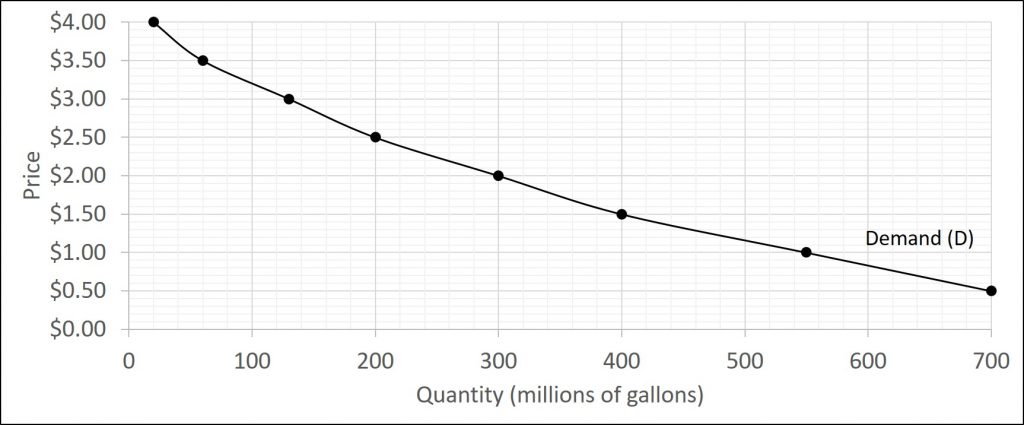
The Law of Demand
Demand curves will appear somewhat different for each product. They may appear relatively steep or flat, or they may be straight or curved. Nearly all demand curves share the fundamental similarity that they slope down from left to right. Demand curves embody the law of demand: As the price increases, the quantity demanded decreases, and conversely, as the price decreases, the quantity demanded increases.
Demand versus Quantity Demanded
In economic terminology, demand is not the same as quantity demanded. When economists talk about demand, they mean the relationship between a range of prices and the quantities demanded at those prices, as illustrated by a demand curve or a demand schedule. When economists talk about quantity demanded, they mean only a certain point on the demand curve or one quantity on the demand schedule. In short, demand refers to the curve and quantity demanded refers to the (specific) point on the curve.
Individual and Market Demand
| Price | QD1 | QD2 | QD3 | = | Market QD |
|---|---|---|---|---|---|
| $0.25 | 25 | 6 | 18 | = | 49 |
| $0.50 | 21 | 5 | 15 | = | 41 |
| $0.75 | 18 | 4 | 14 | = | 36 |
| $1.00 | 12 | 3 | 12 | = | 27 |
| $1.25 | 7 | 2 | 10 | = | 19 |
| $1.50 | 4 | 1 | 8 | = | 13 |
Shifts in Demand
The previous module explored how price affects the quantity demanded. The result was the demand curve. Price, however, is not the only factor that influences demand. For example, how is demand for vegetarian food affected if, say, health concerns cause more consumers to avoid eating meat? What are the major factors, in addition to the price, that influence demand?
We defined demand as the amount of some product a consumer is willing and able to purchase at each price. That suggests at least two factors in addition to price that affects demand. Willingness to purchase suggests a desire, based on what economists call tastes and preferences. If you neither need nor want something, you will not buy it. Ability to purchase suggests that income is important. Professors are usually able to afford better housing and transportation than students because they have more income. Prices of related goods can affect demand also. If you need a new car, the price of a Honda may affect your demand for a Ford. Finally, the size or composition of the population can affect demand. The more children a family has, the greater their demand for clothing. The more driving-age children a family has, the greater their demand for car insurance, and the less for diapers and baby formula.
These factors matter for both individual and market demand as a whole. Exactly how do these various factors affect demand, and how do we show the effects graphically? To answer those questions, we need the ceteris paribus assumption.
A demand curve is a relationship between two, and only two, variables: quantity on the horizontal axis and price on the vertical axis. The assumption behind a demand curve is that no relevant economic factors, other than the product’s price, are changing. Economists call this assumption ceteris paribus, a Latin phrase meaning “other things being equal.” Any given demand curve is based on the ceteris paribus assumption that all else is held equal. A demand curve is a relationship between two, and only two, variables when all other variables are kept constant.
We will discuss a total of six factors which cause the demand curve to shift. You can use the mnemonic device INEPTT (which will be the same when we learn the supply shifters). These include:
- Income levels
- Number of consumers
- Expectations
- Price of related goods
- Tastes
- Taxes
Each will be discussed in more depth shortly. Before we do that, let us explore what a change in demand actually is. Recall, when the price of a good changes, we move along the demand curve. That is, when the price changes, the quantity demanded changes, but the demand stays the same (meaning we stay on the same demand curve.) On the other hand, when one of the shifters above changes, the entire demand curve moves. An increase in demand is shown by an outward shift while a decrease in demand is shown by an inward shift. This is shown graphically below.
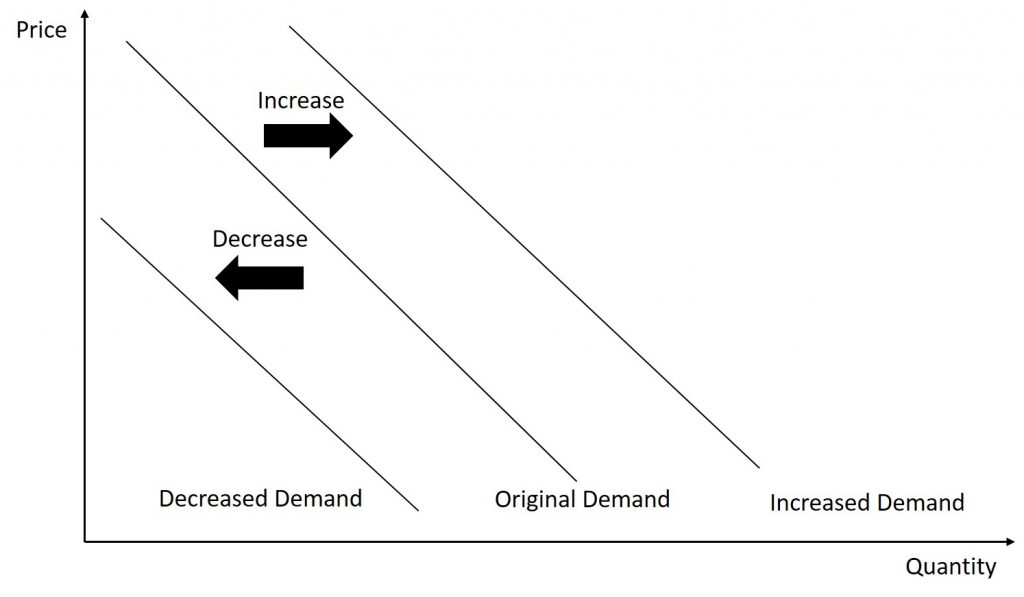
Numerically, what a shift means is that the quantity demanded will be different at each price level. The table below shows both an increase and decrease in demand using the demand schedule presented earlier in the chapter.
| Price (per gallon) | Decrease in Demand | Original Demand | Increase in Demand |
|---|---|---|---|
| $0.50 | 600 | 700 | 850 |
| $1.00 | 480 | 550 | 700 |
| $1.50 | 360 | 400 | 550 |
| $2.00 | 260 | 300 | 450 |
| $2.50 | 180 | 200 | 320 |
| $3.00 | 110 | 130 | 200 |
| $3.50 | 50 | 60 | 100 |
| $4.00 | 10 | 20 | 50 |
Now that we have explored what demand shifts look like, let us examine what can cause these changes. Remember, if the price of the good changes, we move along the demand curve (meaning the demand curve does not move.) It is only if one of the following factors change that the entire demand curve will move.
Changes in Income Levels
Consider the market for cars. Suppose that the market price of a car is $20,000. The original demand curve D, like every demand curve, is based on the ceteris paribus assumption that no other economically relevant factors change. Now imagine that the economy expands in a way that raises the incomes of many people, making cars more affordable. How will this affect demand?
The price of cars is still $20,000, but with higher incomes, the quantity demanded has now increased. As a result of the higher income levels, the demand curve shifts to the right to the new demand curve, indicating an increase in demand. This would occur at every price, not just the original one.
Now, imagine that the economy slows down so that many people lose their jobs or work fewer hours, reducing their incomes. In this case, the decrease in income would lead to a lower quantity of cars demanded at every given price, and the original demand curve would shift left. The shift represents a decrease in demand: At any given price level, the quantity demanded is now lower.
When a demand curve shifts, it does not mean that the quantity demanded by every individual buyer changes by the same amount. In this example, not everyone would have higher or lower income and not everyone would buy or not buy an additional car. Instead, a shift in a demand curve captures a pattern for the market as a whole.
The type of good just discussed is a normal good. That is, a good where if incomes rise the demand increases as well (and vice versa.) This is true for most goods and services. For some—luxury cars, vacations in Europe, and fine jewelry—the effect of a rise in income can be especially pronounced (we will discuss this in a later chapter).
A few exceptions to this pattern do exist. As incomes rise, many people will buy fewer generic brand groceries and more name brand groceries. They are less likely to buy used cars and more likely to buy new cars. They will be less likely to rent an apartment and more likely to own a home. A product whose demand falls when income rises, and vice versa, is called an inferior good. In other words, when income increases, the demand curve shifts to the left and vice versa.
Number of Consumers
This shifter is a bit more straightforward. This shifter is typically thought of as the population. Put simply, as the population of an area increases, the demand will increase and vice versa. This does not necessarily refer to the number of people interested in the product (this will be discussed later) but simply as the number of potential customers.
Expectations
While it is clear that the price of a good affects the quantity demanded, it is also true that expectations about the future price (or expectations about tastes and preferences, income, and so on) can affect demand. For example, if people hear that a hurricane is coming, they may rush to the store to buy flashlight batteries and bottled water. If people learn that the price of a good like coffee is likely to rise in the future, they may head for the store to stock up on coffee now. We show these changes in demand as shifts in the curve. Therefore, a shift in demand happens when a change in some economic factor (other than price) causes a different quantity to be demanded at every price.
Prices of Related Goods
Changes in the prices of related goods such as substitutes or complements also can affect the demand for a product. A substitute is a good or service that we can use in place of another good or service. As electronic books, like this one, become more available, you would expect to see a decrease in demand for traditional printed books. A lower price for a substitute decreases demand for the other product. For example, in recent years as the price of tablet computers has fallen, the quantity demanded has increased (because of the law of demand). Since people are purchasing tablets, there has been a decrease in demand for laptops, which we can show graphically as a leftward shift in the demand curve for laptops. A higher price for a substitute good has the reverse effect.
Other goods are complements for each other, meaning we often use the goods together because consumption of one good tends to enhance the consumption of the other. Examples include breakfast cereal and milk; notebooks and pens or pencils, golf balls and golf clubs; gasoline and sport utility vehicles; and the five-way combination of bacon, lettuce, tomato, mayonnaise, and bread. If the price of golf clubs rises, since the quantity demanded of golf clubs falls (because of the law of demand), demand for a complement good like golf balls decreases, too. Similarly, a higher price for skis would shift the demand curve for a complement good like ski resort trips to the left, while a lower price for a complement has the reverse effect.
Tastes
This category contains several different components.
The first is changes in what consumers want. For instance, from 1980 to 2014, the per-person consumption of chicken by Americans rose from 48 pounds per year to 85 pounds per year, and consumption of beef fell from 77 pounds per year to 54 pounds per year, according to the U.S. Department of Agriculture (USDA). Changes like these are largely due to movements in taste, which change the quantity of a good demanded at every price: that is, they shift the demand curve for that good, rightward for chicken and leftward for beef. Similarly, fad items often see a rapid increase in demand when the item becomes popular and then a rapid shift inward when the item inevitably loses its popularity.
The second change is the demographics of an area. For example, the proportion of elderly citizens in the United States population is rising. It rose from 9.8% in 1970 to 12.6% in 2000 and will be a projected (by the U.S. Census Bureau) 20% of the population by 2030. A society with relatively more children, like the United States in the 1960s, will have greater demand for goods and services like tricycles and daycare facilities. A society with relatively more elderly persons, as the United States is projected to have by 2030, has a higher demand for nursing homes and hearing aids. Similarly, changes in the size of the population can affect the demand for housing and many other goods. Each of these changes in demand will be shown as a shift in the demand curve.
Taxes
Taxes have the ability to impact a consumer’s ability to afford a good, but the type of tax impacts the change in demand.
Income taxes will affect demand in the same way as changes in income did because they are essentially the same thing. For instance, an increase in income tax means that people now have less disposable income. Therefore, an increase in income taxes will cause a decrease in the demand for normal goods and an increase in the demand for inferior goods.
A sales tax applied to each good equally will function the same way as the income tax. If you have to pay the same tax (as a percent of its price), your purchasing power is affected in the same way that an income tax affects your purchasing power.
On the other hand, an excise tax, which is a tax on a specific good, then there is movement along the demand curve for that good and not a shift in the entire curve. For instance, a pack of cigarettes may cost $5 but then a $3 tax is applied. The quantity demanded for a $5 pack of cigarettes is greater than the quantity demanded for an $8 pack of cigarettes.
3.2 Supply
The good news is that much of this section is similar, but in many cases opposite, to what we just learned.
When economists talk about supply, they mean the amount of some good or service a producer is willing to supply at each price. Price is what the producer receives for selling one unit of a good or service. A rise in price almost always leads to an increase in the quantity supplied of that good or service, while a fall in price will decrease the quantity supplied. When the price of gasoline rises, for example, it encourages profit-seeking firms to take several actions: expand exploration for oil reserves; drill for more oil; invest in more pipelines and oil tankers to bring the oil to plants for refining into gasoline; build new oil refineries; purchase additional pipelines and trucks to ship the gasoline to gas stations; and open more gas stations or keep existing gas stations open longer hours. Economists call this positive relationship between price and quantity supplied—that a higher price leads to a higher quantity supplied and a lower price leads to a lower quantity supplied—the law of supply. The law of supply assumes that all other variables that affect supply are held constant.
The figure and table below both display the law of supply. Again, a supply schedule shows the different combinations of price and quantity supplied while the supply curve is a graphical representation of the same thing.
| Price (per gallon) | Quantity Supplied (millions of gallons) |
|---|---|
| $0.50 | 40 |
| $1.00 | 90 |
| $1.50 | 140 |
| $2.00 | 170 |
| $2.50 | 200 |
| $3.00 | 220 |
| $3.50 | 240 |
| $4.00 | 250 |
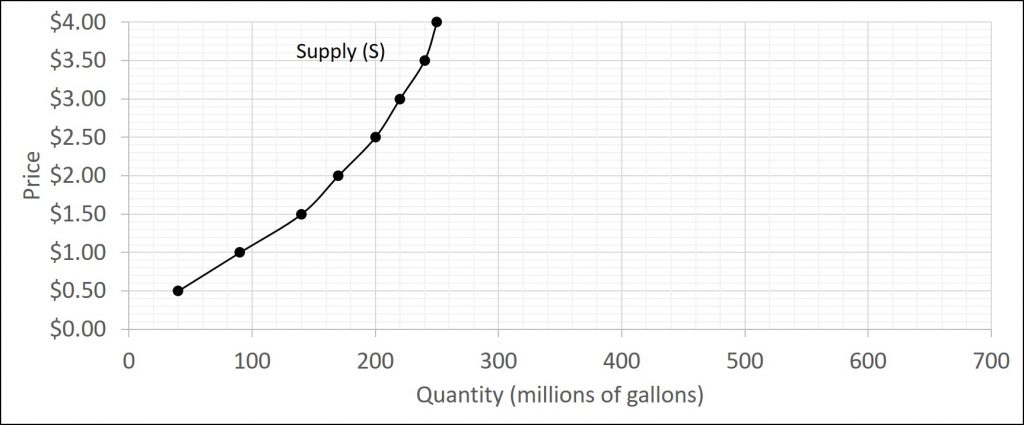
The Law of Supply
Supply curves will appear somewhat different for each product. They may appear relatively steep or flat, or they may be straight or curved. Nearly all supply curves share the fundamental similarity that they slope up from left to right. Supply curves embody the law of supply: As the price increases, the quantity supplied increases, and conversely, as the price decreases, the quantity supplied decreases.
Supply versus Quantity Supplied
In economic terminology, supply is not the same as quantity supplied. When economists talk about supply, they mean the relationship between a range of prices and the quantities supplied at those prices, as illustrated by a supply curve or a supply schedule. When economists talk about quantity supplied, they mean only a certain point on the supply curve, or one quantity on the supply schedule. In short, supply refers to the curve and quantity supplied refers to the (specific) point on the curve.
Individual and market supply
| Price | QS1 | QS2 | QS3 | = | Market QS |
|---|---|---|---|---|---|
| $1.00 | 75 | 125 | 60 | = | 260 |
| $1.50 | 90 | 140 | 80 | = | 310 |
| $2.00 | 110 | 170 | 100 | = | 380 |
| $2.50 | 130 | 190 | 120 | = | 440 |
| $3.00 | 140 | 205 | 130 | = | 475 |
| $3.50 | 145 | 210 | 135 | = | 490 |
Shifts in Supply
The previous module explored how price affects the quantity supplied. The result was the supply curve. Price, however, is not the only factor that influences supply. For example, how is the supply of diamonds affected if diamond producers discover several new diamond mines? What are the major factors, in addition to the price, that influence supply?
These factors matter for both individual and market supply as a whole. Exactly how do these various factors affect supply, and how do we show the effects graphically? To answer those questions, we need the ceteris paribus assumption.
A supply curve is a relationship between two, and only two, variables: quantity on the horizontal axis and price on the vertical axis. The assumption behind a supply curve is that no relevant economic factors, other than the product’s price, are changing. Economists call this assumption ceteris paribus, a Latin phrase meaning “other things being equal.” Any given supply curve is based on the ceteris paribus assumption that all else is held equal. A supply curve is a relationship between two, and only two, variables when all other variables are kept constant.
We will discuss a total of six factors which cause the supply curve to shift. Again, notice INEPTT. These include:
- Input prices (cost of production)
- Number of suppliers
- Expectations
- Price of alternative goods
- Technology
- Taxes
Each will be discussed in more depth shortly. Before we do that, let us explore what a change in supply actually is. Recall, when the price of a good changes, we move along the supply curve. That is, when the price changes, the quantity supplied changes, but the supply stays the same (meaning we stay on the same demand curve.) On the other hand, when one of the shifters above changes, the entire supply curve moves. An increase in supply is shown by an outward shift while a decrease in supply is shown by an inward shift. Be sure to think about shifts as inward or outward. If you think about the shift as moving the curve up or down, you will likely make mistakes with the supply curve. This is shown graphically below.
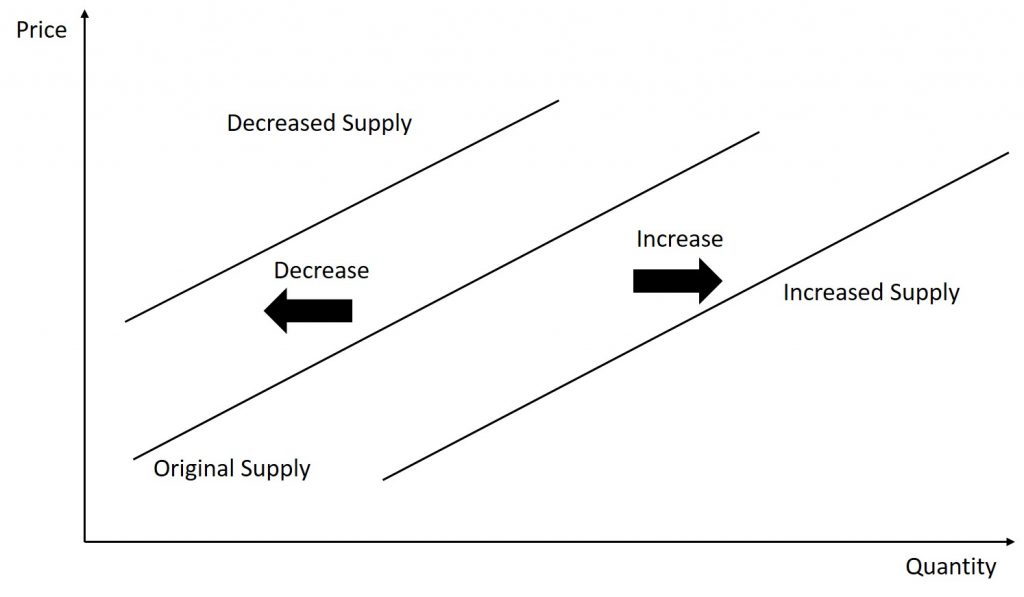
Numerically, what a shift means is that the quantity supplied will be different at each price level. The table below shows a both an increase and decrease in supply using the supply schedule presented earlier in the chapter.
| Price (per gallon) | Decrease in Supply | Original Supply | Increase in Supply |
|---|---|---|---|
| $0.50 | 20 | 40 | 70 |
| $1.00 | 65 | 90 | 130 |
| $1.50 | 110 | 140 | 190 |
| $2.00 | 150 | 170 | 240 |
| $2.50 | 175 | 200 | 280 |
| $3.00 | 190 | 220 | 310 |
| $3.50 | 200 | 240 | 340 |
| $4.00 | 205 | 250 | 360 |
Now that we have explored what supply shifts look like, let us examine what can cause these changes. Remember, if the price of the good changes, we move along the supply curve (meaning the supply curve does not move.) It is only if one of the following factors change that the entire supply curve will move.
Input Costs
A supply curve shows how quantity supplied will change as the price rises and falls, assuming ceteris paribus so that no other economically relevant factors are changing. If other factors relevant to supply do change, then the entire supply curve will shift. Just as we described a shift in demand as a change in the quantity demanded at every price, a shift in supply means a change in the quantity supplied at every price.
In thinking about the factors that affect supply, remember what motivates firms: profits, which are the difference between revenues and costs. A firm produces goods and services using combinations of labor, materials, and machinery, or what we call inputs or factors of production. If a firm faces lower costs of production, while the prices for the good or service the firm produces remain unchanged, a firm’s profits go up. When a firm’s profits increase, it is more motivated to produce output, since the more it produces the more profit it will earn. When costs of production fall, a firm will tend to supply a larger quantity at any given price for its output. We can show this by the supply curve shifting to the right.
Take, for example, a messenger company that delivers packages around a city. The company may find that buying gasoline is one of its main costs. If the price of gasoline falls, then the company will find it can deliver messages more cheaply than before. Since lower costs correspond to higher profits, the messenger company may now supply more of its services at any given price. For example, given the lower gasoline prices, the company can now serve a greater area and increase its supply.
Conversely, if a firm faces higher costs of production, then it will earn lower profits at any given selling price for its products. As a result, a higher cost of production typically causes a firm to supply a smaller quantity at any given price. In this case, the supply curve shifts to the left.
Imagine that the price of steel, an important ingredient in manufacturing cars, rises, so that producing a car has become more expensive. At any given price for selling cars, car manufacturers will react by supplying a lower quantity. We can show this graphically as a leftward shift of supply.
Conversely, if the price of steel decreases, producing a car becomes less expensive. At any given price for selling cars, car manufacturers can now expect to earn higher profits, so they will supply a higher quantity. The shift of supply to the right.
Number of Suppliers
This shifter is a bit more straightforward. This shifter is typically thought of as the number of firms. Put simply, as more firms enter the market, the supply will increase and vice versa.
Expectations
Just as was the case with demand, firms will make decisions not only using current conditions but will also use expected changes to make decisions as well. For instance, if a firm expects the value of its product to increase in six months, they may temporarily decrease the amount of product they make available in order to make more of it available when the price goes up sometime in the future. For example, toy companies produce a significant amount of inventory throughout the year but do not make it available for sale until the holiday season. In addition, if a firm expects the cost of its inputs to rise, they may increase production today to avoid the higher cost of production that may occur later.
Price of Alternative Goods
Here we consider a single firm that produces more than one good. We know from the previous chapter that firms face a production possibilities frontier meaning that they can only produce so much given their factors of production. Therefore, the profitability of one good may impact the supply of another.
For example, consider a firm that produces widgets and gizmos. Now, suppose that the price of a widget increases. Since the price of the widget went up, the quantity supplied of widgets will increase. But, in order to produce more widgets, the firm must shift some resources away from gizmo production. Therefore, the supply of gizmos decreases.
Be careful with terminology here. In the previous example, when the price of the widget changed, the quantity supplied of widgets changed, but the supply of gizmos changed. This is because the price of gizmos did not impact gizmo; instead, if was an external factor (in this case, the price of widgets) that affected production.
In summary, when the price of an alternative good (produced by the same firm) increases, the supply of the other good decreases and vice versa.
Technology
When a firm discovers a new technology that allows the firm to produce at a lower cost, the supply curve will shift to the right, as well. For instance, in the 1960s a major scientific effort nicknamed the Green Revolution focused on breeding improved seeds for basic crops like wheat and rice. By the early 1990s, more than two-thirds of the wheat and rice in low-income countries around the world used these Green Revolution seeds—and the harvest was twice as high per acre. A technological improvement that reduces costs of production will shift supply to the right so that a greater quantity will be produced at any given price.
Taxes
Government policies can affect the cost of production and the supply curve through taxes, regulations, and subsidies. For example, the U.S. government imposes a tax on alcoholic beverages that collects about $8 billion per year from producers. Businesses treat taxes as costs. Higher costs decrease supply for the reasons we discussed above. Other examples of policy that can affect cost are the wide array of government regulations that require firms to spend money to provide a cleaner environment or a safer workplace. Complying with regulations increases costs.
A government subsidy, on the other hand, is the opposite of a tax. A subsidy occurs when the government pays a firm directly or reduces the firm’s taxes if the firm carries out certain actions. From the firm’s perspective, taxes or regulations are an additional cost of production that shifts supply to the left, leading the firm to produce a lower quantity at every given price. Government subsidies reduce the cost of production and increase supply at every given price, shifting supply to the right.
3.3 putting supply and demand together
Equilibrium
Because the graphs for demand and supply curves both have price on the vertical axis and quantity on the horizontal axis, the demand curve and supply curve for a particular good or service can appear on the same graph. Together, demand and supply determine the price and the quantity that will be bought and sold in a market.
Remember this: When two lines on a diagram cross, this intersection usually means something. The point where the supply curve (S) and the demand curve (D) cross in the figure below is called the equilibrium. The equilibrium price is the only price where the plans of consumers and the plans of producers agree—that is, where the amount of the product consumers want to buy (quantity demanded) is equal to the amount producers want to sell (quantity supplied). Economists call this common quantity the equilibrium quantity. At any other price, the quantity demanded does not equal the quantity supplied, so the market is not in equilibrium at that price.
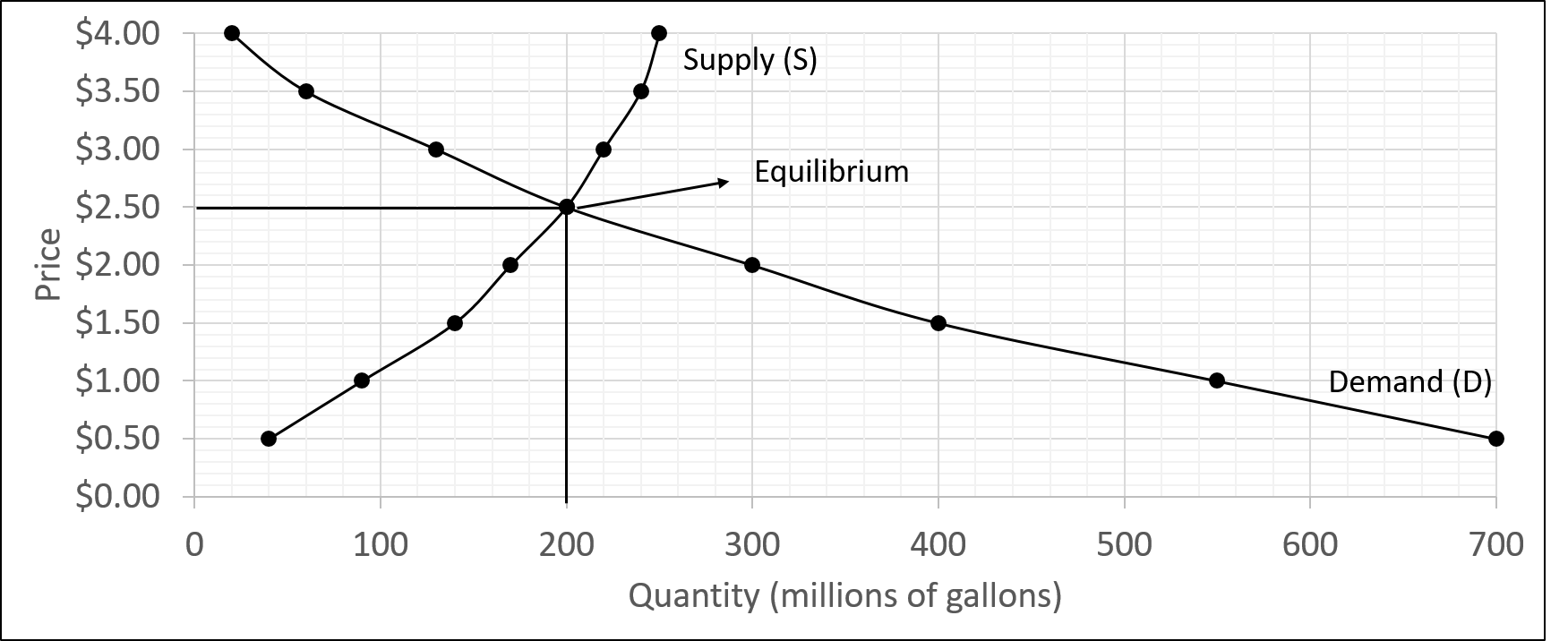
| Price (per gallon) | Quantity Demanded (millions of gallons) | Quantity Supplied (millions of gallons) |
|---|---|---|
| $0.50 | 700 | 40 |
| $1.00 | 550 | 90 |
| $1.50 | 400 | 140 |
| $2.00 | 300 | 170 |
| $2.50 | 200 | 200 |
| $3.00 | 130 | 220 |
| $3.50 | 60 | 240 |
| $4.00 | 20 | 250 |
In the figure above, the equilibrium price is $2.50 per gallon of gasoline and the equilibrium quantity is 200 million gallons. If you had only the demand and supply schedules, and not the graph, you could find the equilibrium by looking for the price level on the tables where the quantity demanded and the quantity supplied are equal.
The word “equilibrium” means “balance.” If a market is at its equilibrium price and quantity, then it has no reason to move away from that point. However, if a market is not at equilibrium, then economic pressures arise to move the market toward the equilibrium price and the equilibrium quantity.
Market Failures
Imagine, for example, that the price of a gallon of gasoline was above the equilibrium price—that is, instead of $2.50 per gallon, the price is $3.00 per gallon. The horizontal line at the price of $3.00 in the figure below illustrates this above equilibrium price. At this higher price, the quantity demanded drops from 200 to 130. This decline in quantity reflects how consumers react to the higher price by finding ways to use less gasoline.
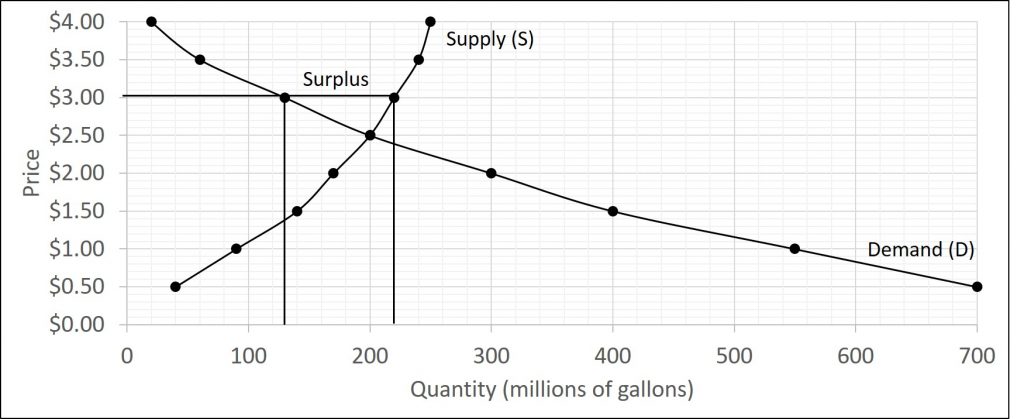
Moreover, at this higher price of $3.00, the quantity of gasoline supplied rises from the 200 to 220, as the higher price makes it more profitable for gasoline producers to expand their output. Now, consider how quantity demanded and quantity supplied are related at this above-equilibrium price. Quantity demanded has fallen to 130 gallons, while quantity supplied has risen to 220 gallons. In fact, at any above-equilibrium price, the quantity supplied exceeds the quantity demanded. We call this an excess supply or a surplus. In this example, the surplus is 220-130=90 million gallons.
With a surplus, gasoline accumulates at gas stations, in tanker trucks, in pipelines, and at oil refineries. This accumulation puts pressure on gasoline sellers. If a surplus remains unsold, those firms involved in making and selling gasoline are not receiving enough cash to pay their workers and to cover their expenses. In this situation, some producers and sellers will want to cut prices, because it is better to sell at a lower price than not to sell at all. Once some sellers start cutting prices, others will follow to avoid losing sales. These price reductions, in turn, will stimulate a higher quantity demanded. Therefore, if the price is above the equilibrium level, incentives built into the structure of demand and supply will create downward price pressure.
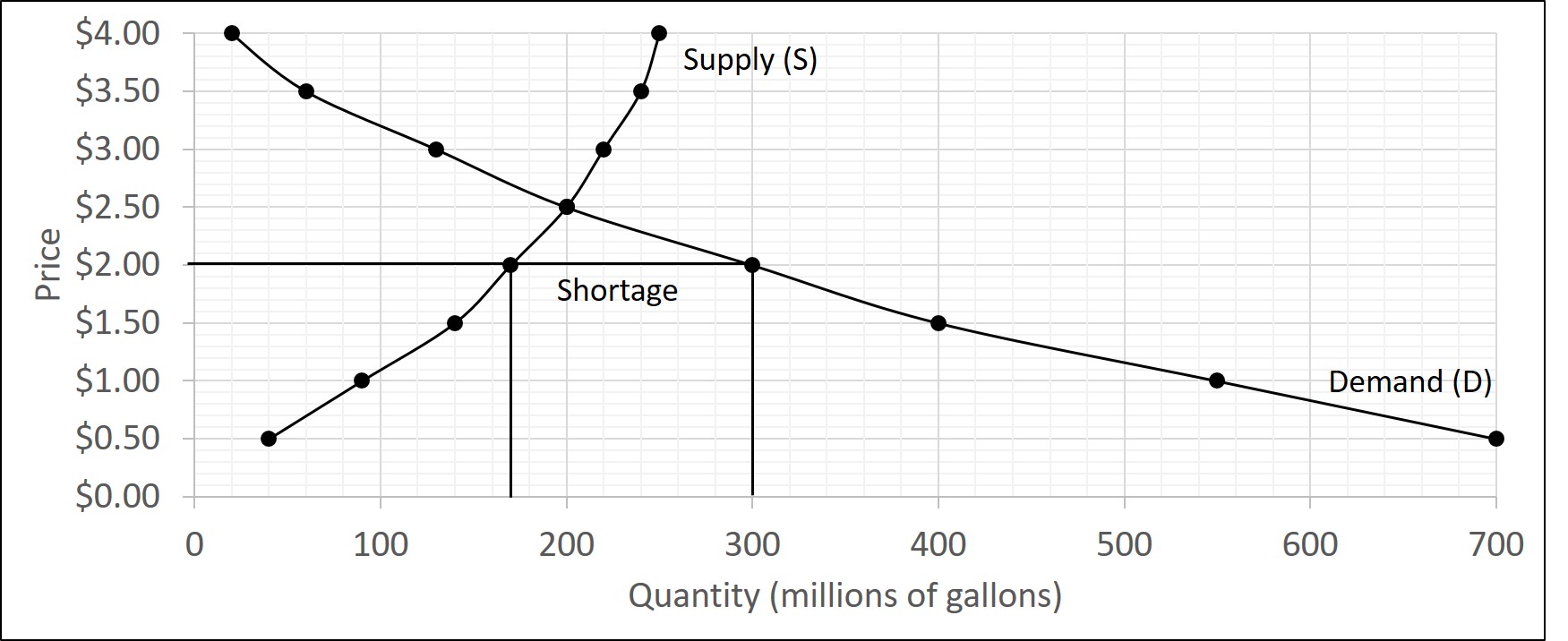
Now suppose that the price is below its equilibrium level at $2.00 per gallon, as the horizontal line at this price in Figure 3.7 shows. At this lower price, the quantity demanded increases from 200 to 300 as drivers take longer trips, spend more minutes warming up the car in the driveway in wintertime, stop sharing rides to work, and buy larger cars that get fewer miles to the gallon. However, the below-equilibrium price reduces gasoline producers’ incentives to produce and sell gasoline, and the quantity supplied falls from 200 to 170.
When the price is below equilibrium, there is excess demand, or a shortage—that is, at the given price the quantity demanded, which has been stimulated by the lower price, now exceeds the quantity supplied, which had been depressed by the lower price. In our example, the shortage is 300-170=130 millions of gallons. In this situation, eager gasoline buyers mob the gas stations, only to find many stations running short of fuel. Oil companies and gas stations recognize that they have an opportunity to make higher profits by selling what gasoline they have at a higher price. As a result, the price rises toward the equilibrium level.
3.4 Modeling market disequilibrium
Single Shifts
Let’s begin this discussion with a single economic event. It might be an event that affects demand, like a change in income, population, tastes, prices of substitutes or complements, or expectations about future prices. It might be an event that affects supply, like a change in natural conditions, input prices, or technology, or government policies that affect production. How does this economic event affect equilibrium price and quantity? We will analyze this question using a four-step process.
Step 1. Draw a demand and supply model before the economic change took place. To establish the model requires four standard pieces of information: The law of demand, which tells us the slope of the demand curve; the law of supply, which gives us the slope of the supply curve; the shift variables for demand; and the shift variables for supply. From this model, find the initial equilibrium values for price and quantity.
Step 2. Decide whether the economic change you are analyzing affects demand or supply. In other words, does the event refer to something in the list of demand factors or supply factors? Which specific factor is it affecting? Then, decide whether the effect on demand or supply causes the curve to shift to the right or to the left, and sketch the new demand or supply curve on the diagram. In other words, does the event increase or decrease the amount consumers want to buy or producers want to sell?
Step 3. It is important to remember that in step 2, the only thing to change was the supply or demand. Therefore, coming into step 3, the price is still equal to the initial equilibrium price. Since either supply or demand changed, the market is in a state of disequilibrium. Thus, there is either a surplus or shortage. Determine which one exists. Next, determine what prices must do to reequilibrate the market. Remember, if there is a shortage, there will be upward price pressure and if there is a surplus, then there is downward price pressure. Prices continue to adjust until the market achieves a new equilibrium.
Step 4. Identify the new equilibrium and then compare the original equilibrium price and quantity to the new equilibrium price and quantity.
Example 1 (Supply)
Scenario: The market for fast food in a certain town is initially in equilibrium. Several new fast-food restaurants open in the town. Show the impact of the new fast-food restaurants on the equilibrium price and quantity of fast food in this town.
Step 1. We begin by creating a supply and demand graph that is initially in equilibrium.
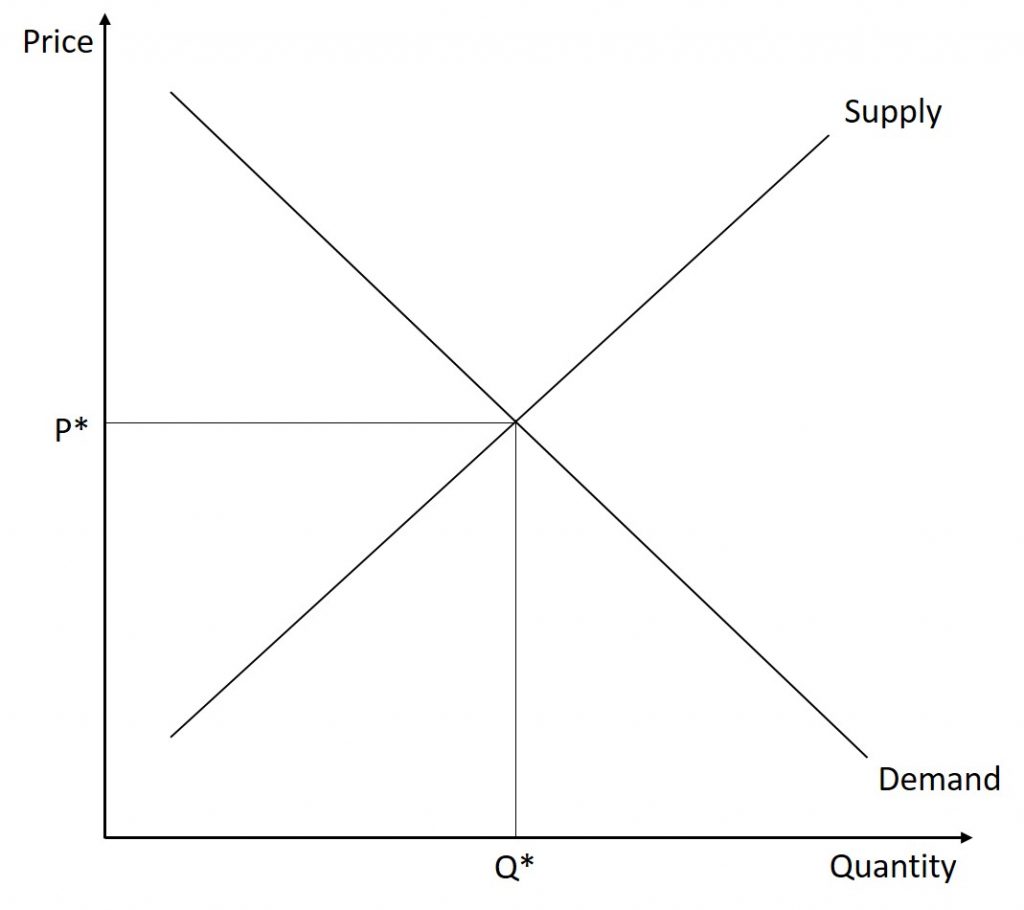
Step 2. This change affects the supply of fast food. Specifically, the number of suppliers has increased. Therefore, the supply of fast food has increased. This causes an outward shift of the supply curve.
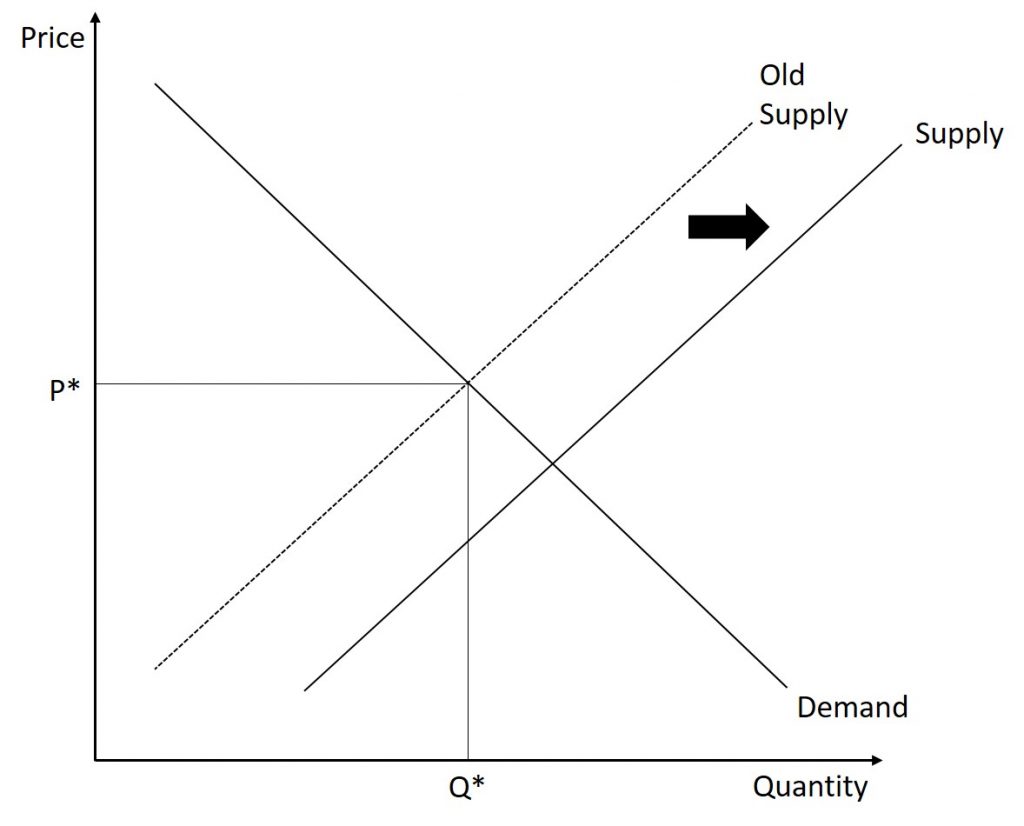
Step 3. At the original price level, the quantity demanded is less than the quantity supplied. Therefore, the market currently has a surplus. In order to alleviate the surplus, the price of fast food must begin to fall (downward price pressure.) This continues until the market achieves its new equilibrium.
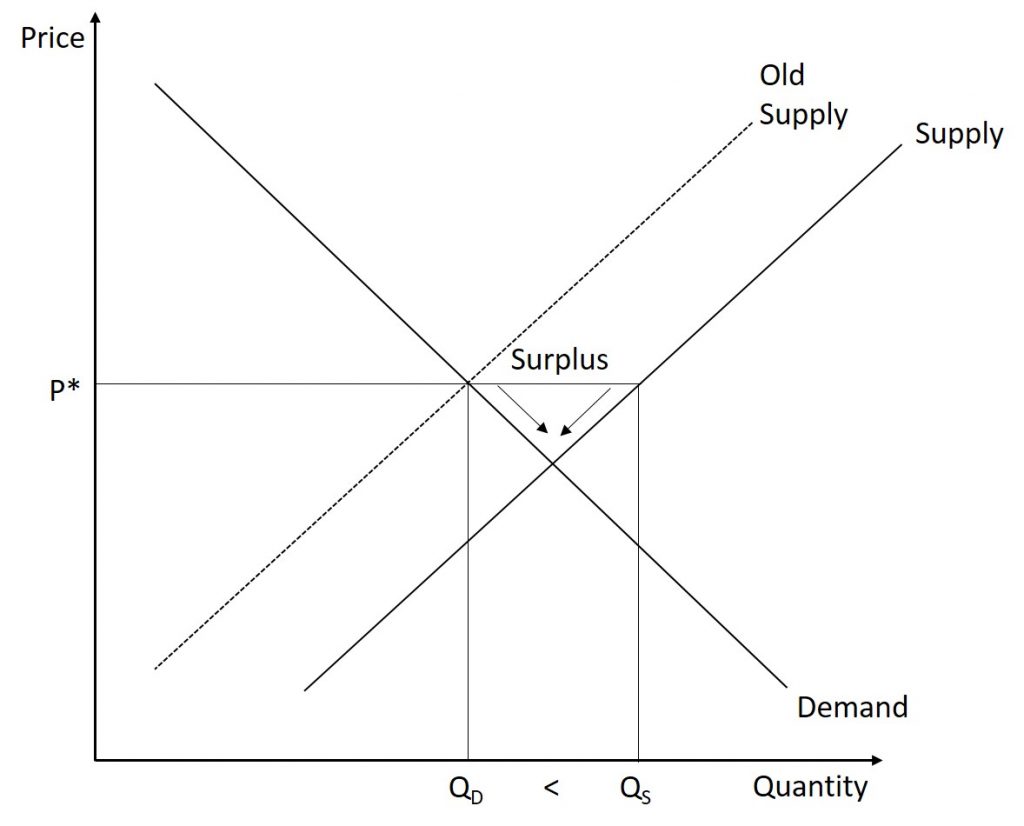
Step 4. We now compare the initial equilibrium to the new equilibrium. We can see that the price of fast food has fallen but the quantity of fast food has increased.
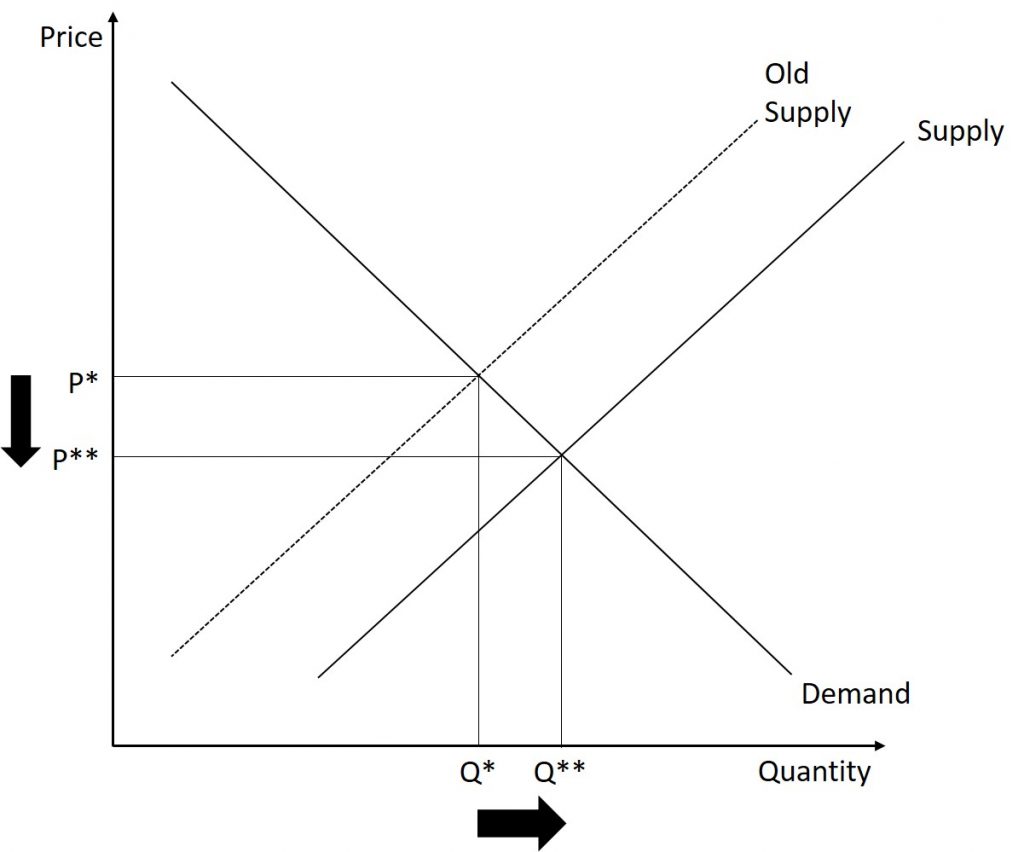
Example 2 (Demand)
Scenario: The market for pickup trucks is initially in equilibrium. A new marketing campaign is successful and creates a new desire to own pickup trucks. Show the impact of the advertising campaign on the equilibrium price and quantity of pickup trucks.
Step 1. We begin by creating a supply and demand graph that is initially in equilibrium.
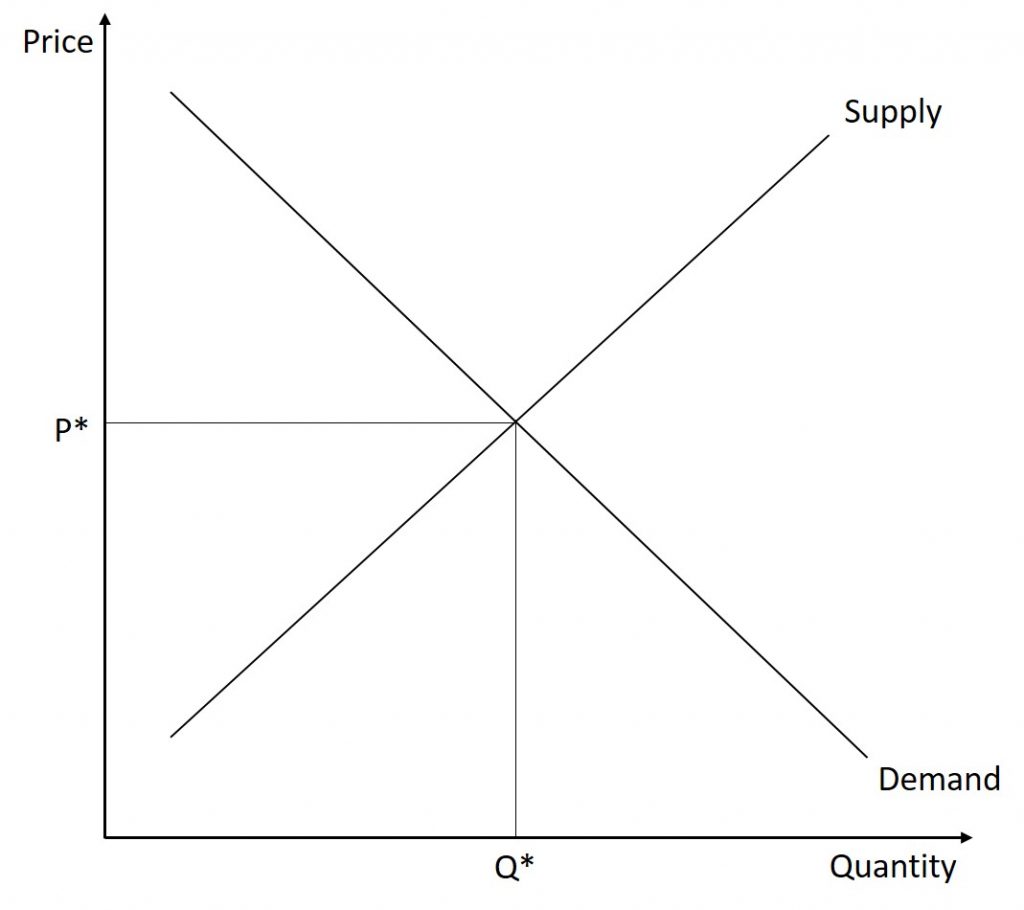
Step 2. This change affects the demand for pickup trucks. Specifically, the tastes of consumers have changed. Therefore, the demand for pickup trucks has increased. This causes an outward shift of the demand curve.
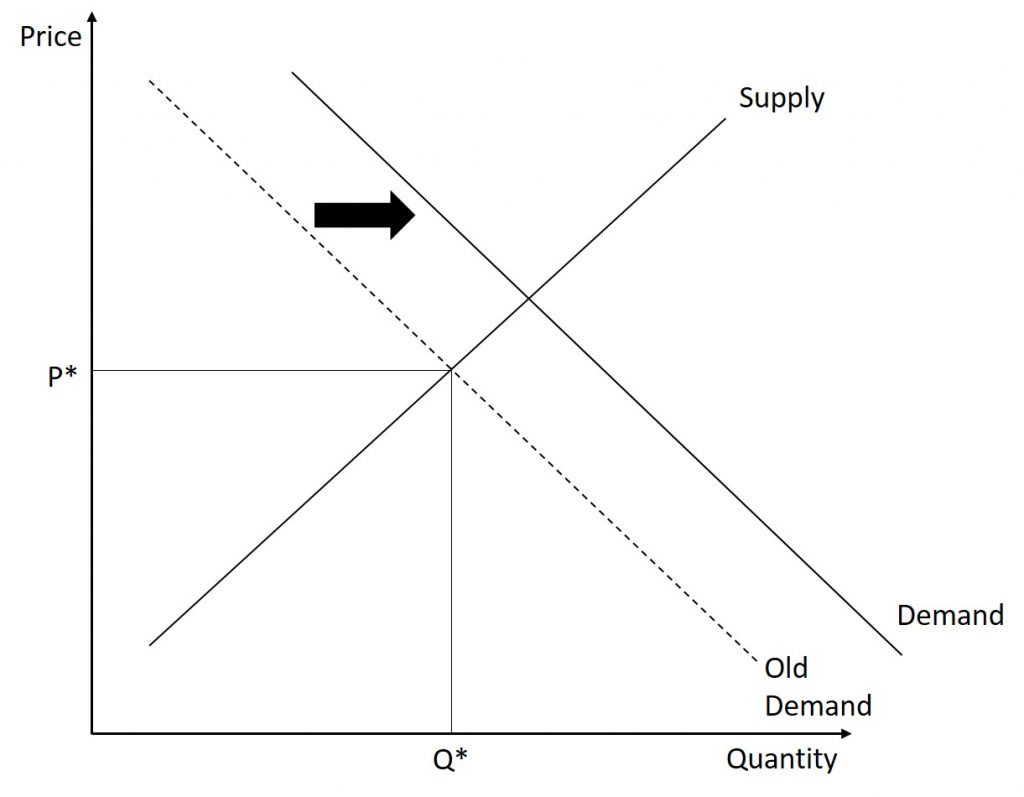
Step 3. At the original price level, the quantity supplied is less than the quantity demanded. Therefore, the market currently has a shortage. In order to alleviate the shortage, the price of pickup trucks will begin to increase (upward price pressure.) This continues until the market achieves its new equilibrium.
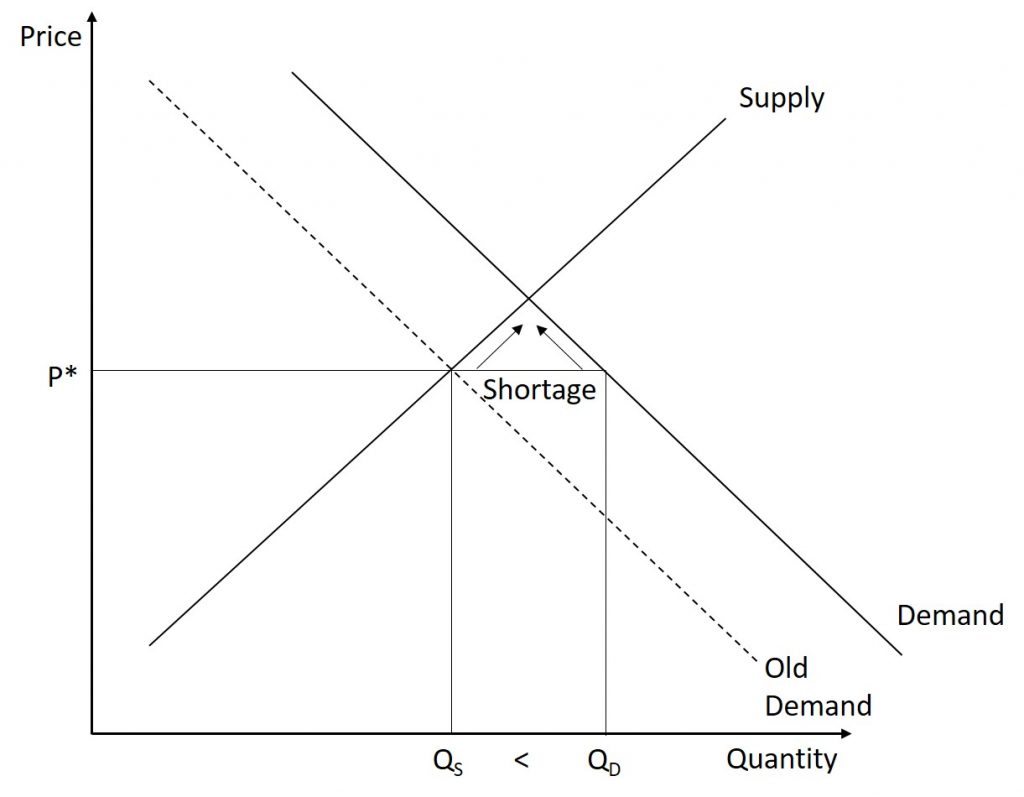
Step 4. We now compare the initial equilibrium to the new equilibrium. We can see that the price of pickup trucks has increased and the quantity of pickup trucks has increased.
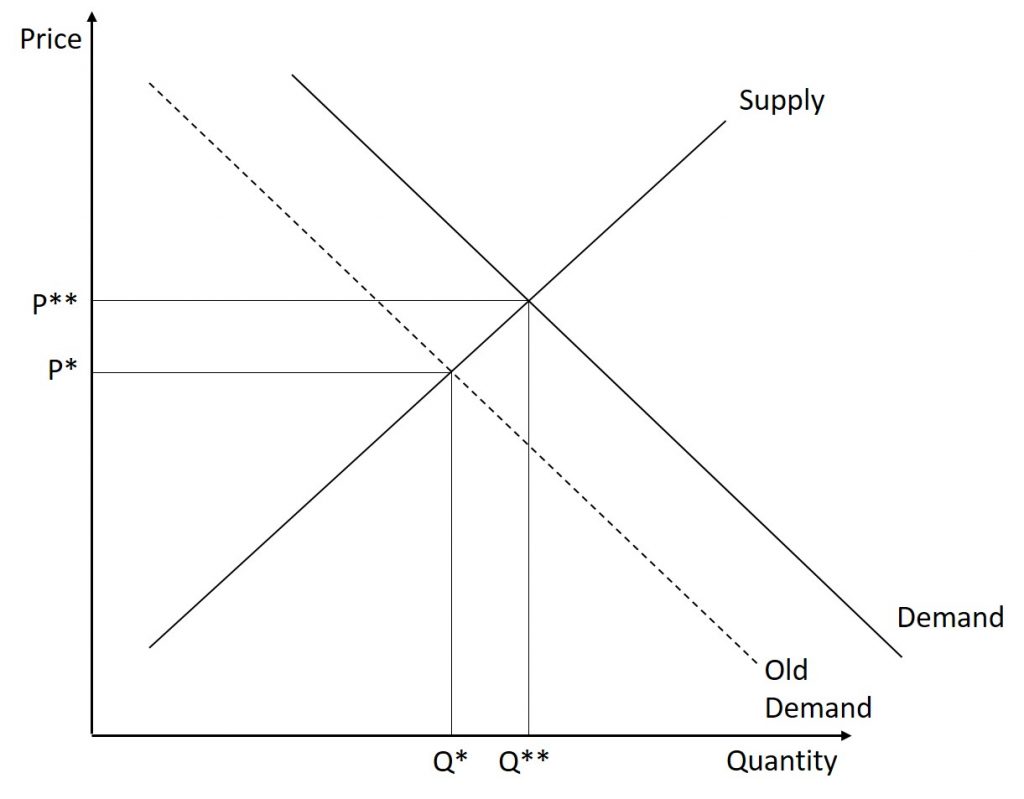
Summary of Shifts
Regardless of the cause of the shift, there are only a total of four possible cases. We can have an increase or decrease in supply or demand. Each scenario has its own unique template. The results are summarized below.
| Curve Shift / Change | Increase | Decrease |
|---|---|---|
| Demand | P↑ Q↑ | P↓ Q↓ |
| Supply | P↓ Q↑ | P↑ Q↓ |

